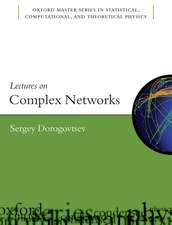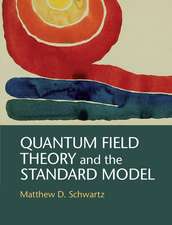Econophysics of Wealth Distributions: Econophys-Kolkata I: New Economic Windows
Editat de Arnab Chatterjee, Sudhakar Yarlagadda, Bikas K. Chakrabartien Limba Engleză Hardback – 19 iul 2005
| Toate formatele și edițiile | Preț | Express |
|---|---|---|
| Paperback (1) | 379.54 lei 6-8 săpt. | |
| Springer – 15 noi 2014 | 379.54 lei 6-8 săpt. | |
| Hardback (1) | 386.77 lei 6-8 săpt. | |
| Springer – 19 iul 2005 | 386.77 lei 6-8 săpt. |
Din seria New Economic Windows
- 18%
 Preț: 937.87 lei
Preț: 937.87 lei - 15%
 Preț: 636.20 lei
Preț: 636.20 lei -
 Preț: 392.07 lei
Preț: 392.07 lei -
 Preț: 380.34 lei
Preț: 380.34 lei - 15%
 Preț: 624.46 lei
Preț: 624.46 lei - 18%
 Preț: 1372.05 lei
Preț: 1372.05 lei - 18%
 Preț: 777.75 lei
Preț: 777.75 lei - 18%
 Preț: 768.58 lei
Preț: 768.58 lei - 18%
 Preț: 935.24 lei
Preț: 935.24 lei -
 Preț: 372.76 lei
Preț: 372.76 lei - 15%
 Preț: 633.78 lei
Preț: 633.78 lei -
 Preț: 392.98 lei
Preț: 392.98 lei -
 Preț: 383.93 lei
Preț: 383.93 lei -
 Preț: 379.54 lei
Preț: 379.54 lei - 18%
 Preț: 925.93 lei
Preț: 925.93 lei -
 Preț: 383.18 lei
Preț: 383.18 lei - 18%
 Preț: 716.93 lei
Preț: 716.93 lei - 18%
 Preț: 935.87 lei
Preț: 935.87 lei - 18%
 Preț: 933.09 lei
Preț: 933.09 lei - 15%
 Preț: 632.17 lei
Preț: 632.17 lei - 15%
 Preț: 634.60 lei
Preț: 634.60 lei - 15%
 Preț: 575.56 lei
Preț: 575.56 lei - 15%
 Preț: 683.80 lei
Preț: 683.80 lei - 15%
 Preț: 625.92 lei
Preț: 625.92 lei - 18%
 Preț: 773.40 lei
Preț: 773.40 lei - 15%
 Preț: 623.49 lei
Preț: 623.49 lei - 18%
 Preț: 1093.38 lei
Preț: 1093.38 lei
Preț: 386.77 lei
Nou
Puncte Express: 580
Preț estimativ în valută:
74.05€ • 77.11$ • 61.44£
74.05€ • 77.11$ • 61.44£
Carte tipărită la comandă
Livrare economică 12-26 februarie
Preluare comenzi: 021 569.72.76
Specificații
ISBN-13: 9788847003293
ISBN-10: 8847003296
Pagini: 248
Ilustrații: IX, 248 p.
Dimensiuni: 155 x 235 x 16 mm
Greutate: 0.54 kg
Ediția:2005
Editura: Springer
Colecția Springer
Seria New Economic Windows
Locul publicării:Milano, Italy
ISBN-10: 8847003296
Pagini: 248
Ilustrații: IX, 248 p.
Dimensiuni: 155 x 235 x 16 mm
Greutate: 0.54 kg
Ediția:2005
Editura: Springer
Colecția Springer
Seria New Economic Windows
Locul publicării:Milano, Italy
Public țintă
Professional/practitionerCuprins
Data and analysis.- Pareto’s Law of Income Distribution: Evidence for Germany, the United Kingdom, and the United States.- Two-class Structure of Income Distribution in the USA: Exponential Bulk and Power-law Tail.- Pareto-Zipf, Gibrat’s Laws, Detailed-Balance and their Breakdown.- Empirical study and model of personal income.- Blockbusters, Bombs and Sleepers: The Income Distribution of Movies.- Models and theories.- Emergent Statistical Wealth Distributions in Simple Monetary Exchange Models: A Critical Review.- Lagrange Principle of Wealth Distribution.- Carnot Process of Wealth Distribution.- Ideal-Gas Like Markets: Effect of Savings.- Kinetic Theory Models for the Distribution of Wealth: Power Law from Overlap of Exponentials.- Detailed Simulation Results for Some Wealth Distribution Models in Econophysics.- Dynamics of Money and Income Distributions.- Dynamic Process of Money Transfer Models.- A Stochastic Trading Model of Wealth Distribution.- Wealth Distribution in a Network with Correlations Between Links and Success.- The Monomodal, Polymodal, Equilibrium and Nonequilibrium Distribution of Money.- Relieving Poverty by Modifying Income and Wealth Distributions.- The Rich Are Different ! Pareto Law from Asymmetric Interactions in Asset Exchange Models.- Do We All Face the Same Constraints?.- Related studies.- A Stochastic Model of Wealth Distribution.- How the Rich Get Richer.- Power-Law Distribution in an Emerging Capital Market.- Statistical Analysis on Bombay Stock Market.- Funds Management by Banks in India: Solution to a Persisting Optimization Problem.- Income Distribution in the Boltzmann-Pareto Framework.- Comments and Discussions.- Econophys-Kolkata: A Short Story.- Econophysics of Wealth Distribution: A Comment.- Econophysics of WealthDistributions: Workshop Summaries.
Textul de pe ultima copertă
Understanding the distribution of income and wealth in an economy has been a classic problem in economics for the last hundred years. Apart from the rapidly decaying number density of people with their income crossing over to a robust power law for the very rich, known as the Pareto power-law, after Vilfredo Pareto. With the availability of accurate data from finance/income-tax departments of various countries, several robust features of the income distribution have been established.
This field had been dormant for more than a decade, although accurate data had been accumulated over this period. The recent enthusiasm comes mainly from the physicists modelling of markets in analogy with physical systems like gases etc. This is the first book reporting exhaustively on these developments over the last decade by leaders in the field
The book will report on the major models developed mainly by the (econo-) physicists over the last decade. Almost all the major physicists and economists involved in these studies will review their latest work and the associated developments.
This field had been dormant for more than a decade, although accurate data had been accumulated over this period. The recent enthusiasm comes mainly from the physicists modelling of markets in analogy with physical systems like gases etc. This is the first book reporting exhaustively on these developments over the last decade by leaders in the field
The book will report on the major models developed mainly by the (econo-) physicists over the last decade. Almost all the major physicists and economists involved in these studies will review their latest work and the associated developments.














